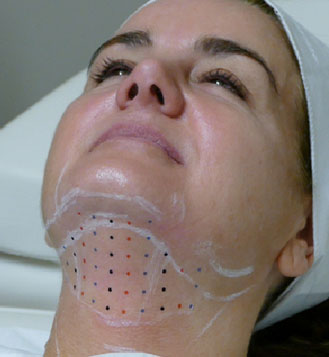
Few accomplishments are as rewarding as waking up in the morning and hitting your target weight. You've worked hard to drop those unwanted pounds all year long, and you deserve a huge round of applause for what you've accomplished. However, if you're like many men and women, getting the sleek, sculpted body you crave is easier said than done. You've got pockets of unwanted fat around your abdomen, thighs, chin, and other areas - fat that just won't go away, despite diet and exercise.
Wouldn't it be nice to just freeze that fat away and forget all about your love handles?
At Southern Cosmetic Laser, our new, revolutionary fat-freezing treatment can help you achieve the toned look you've been dreaming of. That's right - we're talking about literally freezing the unwanted fat off your problem areas without invasive surgeries or extended downtime.
This amazing treatment is called CoolSculpting, and it's the world's leading non-invasive fat reduction procedure. It's specifically designed for people already at their desired weight who want to push past that plateau for real body sculpting results. If you're tired of seeing that excess belly fat, saggy skin, or double chin, CoolSculpting is the procedure for you. Southern Cosmetic Laser offers a wide range of the newest technologies to target fat reduction, skin tightening, facial and body remodeling, body toning, and cellulite reduction.

Our Services
Services Area

What is CoolSculpting?

CoolSculpting is an FDA-approved procedure that has undeniable results. With CoolSculpting, you can permanently get rid of your muffin top, fat around your flanks, and more, all from the comfort and convenience of the Southern Cosmetic Laser office.
Technically known as cryolipolysis, CoolSculpting has the ability to reduce the number of fat cells in targeted areas between 20 and 25%. This unique technology uses controlled cooling to freeze and eliminate fat with minimal recovery time. No needles, no scalpels, no liposuction. Just real results provided by a licensed, experienced professional.
While CoolSculpting helps eliminate fat cells in your body, it doesn't harm the surrounding skin and muscles. Instead, it treats fat that is directly under the skin, also called subcutaneous fat. Since CoolSculpting doesn't target visceral fat deposits, this treatment works best for men and women who are approaching or already at their desired weight.
CoolSculpting is approved by the FDA to help reduce fat in the following areas:
- Flanks
- Outer Thighs
- Upper Arms
- Inner Thighs
- Chin
- Back
- Belly and Abdomen
How Does CoolSculpting Work?

CoolSculpting results are noticeable, proven, and long-lasting, helping you look your best and feel great from every angle. This exciting procedure works because fat cells freeze at higher temps than other tissues. As such, CoolSculpting delivers controlled, targeted cooling to do away with unwanted fat underneath your skin. These fat cells are essentially frozen or crystallized and eventually die. With time, your body will process that fat and will eliminate the dead cells, leaving behind a more sculpted physique.
Here are some quick CoolSculpting facts at a glance, so you have a better idea of why this fat cell elimination treatment is so popular:
- There is no prep time required for CoolSculpting from Southern Cosmetic Laser.
- Patients can expect some very minor discomfort during the procedure. Many patients report no discomfort at all.
- There is little-to-no downtime needed after your CoolSculpting procedure is complete.
- It may take up to 12-16 weeks to see your final results.
- This procedure eliminates fat permanently!

Southern Cosmetic Laser's CoolSculpting Procedure

Our CoolSculpting procedure is crafted around your comfort, with one-on-one attention in a relaxing atmosphere. It all starts with a detailed assessment, which you will complete prior to your treatment. This assessment will help us better understand your goals and desires, so we can freeze away the stubborn fat from the areas that matter most.
Typical CoolSculpting appointments take about an hour per area, though that time varies with each patient. Because our CoolSculpting applicators use a vacuum system to help with placement, you may feel a pulling sensation in the targeted area. Once placement is complete, we get to work on freezing your fat.
Before treatment, your skin is prepped with an alcohol wipe. A gel pad is then placed on your treatment area to help protect your skin. From there, a cold sensation is delivered through our applicators, which are designed for specific body parts.
Because there is no sedation involved with CoolSculpting, we encourage you to kick back, relax, and watch a little TV. If you prefer, you can also read or use your phone to check your favorite social media sites. Our friendly, experienced CoolSculpting technicians strive to keep you as comfy as possible during this quick treatment. When it's over, you can resume normal activities as soon as you like - there's no recovery or downtime to worry about!


Top CoolSculpting Treatment Areas

CoolSculpting procedures are perhaps best known for eliminating stubborn belly fat, giving the patient a desirable, contoured tummy. However, this treatment is also very effective on other areas of your body:
CoolSculpting for Your Double Chin
While neck fat usually goes hand-in-hand with weight gain, symptoms like double chins can appear even if you're not overweight. CoolSculpting helps solve neck fat problems by eliminating fat cells in the area below your chin, giving you a slim, youthful appearance.

CoolSculpting for Unwanted Belly Fat
Many men and women begin CoolSculpting treatments to destroy fat around the abdomen or midsection. CoolSculpting does so by freezing stubborn subcutaneous fat in the abdominal region, resulting in a trimmed-up tummy. Remember, CoolSculpting does not treat visceral fat, or the fatty tissue surrounding the organs in your abdomen.

CoolSculpting for Your Back
Back fat is a serious problem for many people in the U.S. This includes the upper back (where fat rolls over the bra), the mid-back (near the waist), and the lower back (where fat bulges over the beltline). Back fat can be hard to tone, but with CoolSculpting from Southern Cosmetic Laser in St. George, it's more than possible.

CoolSculpting for Your Upper Arms
When it comes to stubborn fat, your upper arms are often the most difficult areas to treat. If you are constantly trying to hide your upper arms from friends and family, CoolSculpting is an excellent option to help overcome your insecurity.

CoolSculpting for Your Love Handles
Sometimes called saddlebags or flanks, love handles are the flabby areas that protrude from your hips. Love handles are often caused by fat retention over long periods of time. They can appear very pronounced in tight clothing, leading to feelings of embarrassment. Common factors that contribute to love handles are age, slow metabolism, hormones, and diets high in sugars and fats. With Southern Cosmetic Laser's CoolSculpting, patients leave behind stubborn love handles, helping them achieve a slimmer, more fit appearance.

CoolSculpting for Your Thighs
If you are in good shape but suffer from chafing or discomfort due to fatty thighs, your solution could be at Southern Cosmetic Laser. Our technicians can help freeze away inner thigh fat, so you feel proud to wear skirts, shorts, and bikinis.


Questions About CoolSculpting? We've Got Answers
Q: Does CoolSculpting really work?
A: Yes! Southern Cosmetic Laser wouldn't be one of the most trusted providers of the treatment if it didn't work. According to recent statistics, CoolSculpting treatments can reduce fat reduction by as much as 25% in the affected area. Contact our office today for your initial consultation, where our team will advise you on how many treatments you need to meet your goals.
Q: How much does CoolSculpting cost?
A: Pricing varies depending on the areas you focus on and how many sessions you need in order to reach your goals. Our team will craft a custom treatment plan specific to you during your initial CoolSculpting consultation.
Q: How quickly will I see results?
A: Many patients can see results as soon as three weeks after their first CoolSculpting procedure in St. George. As your body continues to dispose of crystallized fat cells, you can see even more changes with time.
Q: Does CoolSculpting eliminate cellulite?
A: CoolSculpting is designed for fat reduction. However, it may help contribute to cellulite reduction in specific treatment areas. There are currently no FDA clearances for cellulite reduction with CoolSculpting. However, our office offers incredible treatments like Inmode Evolve to reduce the appearance of cellulite and trim, tighten, and tone your skin.
Q: Why should I choose Southern Cosmetic Laser for CoolSculpting in St. George?
A: Southern Cosmetic Laser is a CoolSculpting certified practice and has completed advanced training at the CoolSculpting University. With a highly-trained staff of medical professionals, we're one of the leading providers of CoolSculpting in South Carolina. We know that peace of mind is precious these days. That's why we're committed to you and your body contouring transformation every step of the way.
Popular Treatments That Complement CoolSculpting

We are a full-service practice offering Medical Aesthetics and Cosmetic Dermatology services. As such, Southern Cosmetic Laser has several innovative treatments that complement your CoolSculpting procedure. Whether you're looking to tighten up that turkey neck or say goodbye to cellulite, we've got a custom treatment option waiting for you.


Cellulite Treatment with Sentient Sculpt
Southern Cosmetic Laser is St. George's first medical aesthetics practice to offer Sentient Sculpt. This exciting new product reduces fat, remodels skin tissue, and regenerates skin collagen, leaving your skin tight and smooth.
Using microwave technology, Sentient Sculpt uses up to 80% of the energy generated to penetrate fat under your skin. This process destroys fat cells and the fibrous bands that cause dimples, or cellulite. The remaining 20% of energy is used on the upper layers of your skin, tightening and contracting it to improve its overall appearance.
Sentient Sculpt benefits include:
- Long-Lasting Results
- Improved Skin Laxity
- Effective Skin Tightening & Fat Reduction
- Fat Cells Permanently Destroyed
- Younger Looking Skin
- Minimal Discomfort
- Built-In Cooling for Maximum Comfort
Contact Southern Cosmetic Laser today to learn more about the benefits of Sentient Sculpt and how it can be paired with CoolSculpting treatments.

Kybella for Your Double Chin
If you're ready to kiss that double chin goodbye, Kybella could be the solution you need. Kybella is a treatment that deoxycholic acid that breaks down fat cells when injected into the treatment area. It provides noticeable results for improved chin profile.
Kybella Benefits Include:
- Permanent destruction of fat cells
- Quick treatment process
- Patients may see results in 2 to 4 treatments

Facial Remodeling with Inmode Evoke
Inmode Evoke is the first and only FDA-approved, non-invasive product for facial remodeling treatment. Evoke offers tightening and lifting for facial rejuvenation and can help you achieve a more defined neck and jawline.
The Evoke Intelligence System regulates temperature and sense impedance every millisecond, providing remarkable results. Using proven bipolar radiofrequency energy, Evoke sub-dermally remodels your facial tissue. The Evoke technology offers precise, consistent power to achieve optimal results.

Tite, Trim, & Tone with Inmode Evolve
This advanced, state-of-the-art Thermal Body Contouring Technology helps to trim, tighten, & tone your skin at the same time. Evolve's cutting-edge tech can destroy fat, reduce cellulite, and tighten skin. The result? A newfound, youthful appearance and feel. This treatment is perfect for your mommy makeover, eliminating muffin tops, sculpting abs, and addressing fat around your thighs, belly, arms, legs, hips, and knees.
Benefits of Inmode Evolve include:
- Tone and Tighten Skin
- Eliminate Fat Cells
- Reduce Crepey Skin
- Reduce Saggy Skin
- Collagen Stimulation for Improved Skin Elasticity
- Smooth Over Stubborn Fat Pockets
- Even Out and Reduce Skin Irregularities
Contact Southern Cosmetic Laser today to learn more about the benefits of Inmode Evolve and how it can be paired with CoolSculpting treatments.

Discover CoolSculpting Precision and Unlimited Beauty with Southern Cosmetic Laser
When it comes to unmatched patient care and body contouring services in St. George, no other practice comes close to Southern Cosmetic Laser. We pour passion into every service we offer, from non-surgical fat cell freezing to laser hair removal. If you're looking to make a change for the better this year, we're here to make your wishes a reality. Contact our office today to learn more about the stunning benefits of CoolSculpting technology. Before you know it, you'll be excited to show off that new bathing suit or bikini on the beach.
 843-277-2240
843-277-2240
Free Consultation
Latest News in St. George, SC
Growing pains may hit St. George with proposed 'cluster' housing development
Jennifer Benthttps://www.postandcourier.com/news/st-george-cluster-housing-dr-horton-dorchester-county/article_6640248e-ba10-11ee-a72f-1ba7e2762225.html
ST. GEORGE — The tiny town in northwest Dorchester County might be getting some new next-door neighbors, and more, in one residential influx than it has ever seen before.If approved by the county, a "cluster" housing development proposed by the D.R. Horton, a national builder, would bring more than 330 new homes and a new zoning designation for roughly 300 rural acres near the "Town of Friendly People."While the development would land on Sugar Hill Road outside town limits, St. George would provide wat...
ST. GEORGE — The tiny town in northwest Dorchester County might be getting some new next-door neighbors, and more, in one residential influx than it has ever seen before.
If approved by the county, a "cluster" housing development proposed by the D.R. Horton, a national builder, would bring more than 330 new homes and a new zoning designation for roughly 300 rural acres near the "Town of Friendly People."
While the development would land on Sugar Hill Road outside town limits, St. George would provide water to the development while Dorchester County Water and Sewer would provide sewer services, said Kiera Reinertsen, the county's planning director. The development would also add an estimated 100 students to Dorchester School District Four and draw on services and amenities from St. George’s Fire Station Nine, Davis-Bailey Park and the town’s library.
“We’ve never had this many houses come in at one time since I’ve been here,” said Mayor Kevin Hart, who has lived in the town for 35 years.
The 2.8-square-mile town is home to roughly 1,800 residents, according to the U.S. Census Bureau. Now the county seat, St. George was originally called George’s Station as a stop along the South Carolina Railroad, now Norfolk Southern. It was incorporated in 1875.
“We haven’t had a housing development like this in this area before. There’s no way we can stop them, but we have to make plans. We won’t know it works until we see how it goes,” Hart said. "... Some want to keep our small-town feeling. It’s a tough battle, and we knew it was coming. You can see the progress coming all way up Highway 78. Harleyville is having the same challenge as St. George.
“We’ve got to hope and pray our best laid plans go well for our little town.”
Described as “America’s largest home builder” on its web site, with operations in 45 markets nationwide and 1 million homes constructed since its inception in 1978, D.R. Horton wants to change zoning for the property for the proposed development from agricultural residential, which allows one-acre home lots, to single family residential (R-1), which reduces lot sizes to a third of an acre.
Rosenwald students recall struggles and hope at reopening of St. George school
Victoria Hansenhttps://www.southcarolinapublicradio.org/sc-news/2023-08-17/rosenwald-graduates-recall-struggles-and-hope-at-restored-st-george-school
Painted bright white with a red, tin roof, the St. George Rosenwald school in Dorchester County looks new. Inside, former student Clara Britt is excited to sit behind a small, wooden desk again.“I never thought that this would happen,” says Britt, giggling like a schoolgirl. She’s about to turn 102-years-old.Sitting beside Britt is former classmate Ordie Brown. He’s 94-years-old and met his wife here.“She was taking home economics,” says Brown. “They were practicing how to cook. ...
Painted bright white with a red, tin roof, the St. George Rosenwald school in Dorchester County looks new. Inside, former student Clara Britt is excited to sit behind a small, wooden desk again.
“I never thought that this would happen,” says Britt, giggling like a schoolgirl. She’s about to turn 102-years-old.
Sitting beside Britt is former classmate Ordie Brown. He’s 94-years-old and met his wife here.
“She was taking home economics,” says Brown. “They were practicing how to cook. She would give me lunch out the window.”
Brown and Britt are reunited for the reopening of the historic St. George school. After years of fundraising, planning and construction, the restored schoolhouse will now serve as a community center and museum, sharing the story of African Americans denied an education and the hope they found in schools like St. George Rosenwald.
Built in 1925, the schoolhouse is known as a Rosenwald school because it was funded in part by Julius Rosenwald. He was the son of Jewish immigrants who became the president of Sears, Roebuck and Company.
Rosenwald met educator Booker T. Washington in 1911. The founder of the Tuskegee Institute believed education was the key to African Americans breaking free from generations of oppression.
Together, the wealthy business owner and the educator born into slavery, set out to build schools for Black children.
At the time, 90% of African Americans lived in the South. Yet, schools for Blacks were just shacks with merely a fraction of the funding as White schools, if they existed at all.
Rosenwald offered to match funding in Black communities that raised money for schools and got the support of local white schoolboards. The idea was to get communities to work together.
Black families, already paying taxes for white schools, struggled, but came up with the money. They knew education could be life changing.
“If you’re a parent who can’t read or write, you want your kids to be able to that,” says former state Sen. John Matthews.
Matthews is grateful for the education he received at a Rosenwald school in Bowen, S.C. He helped raise money for the St. George restoration.
Between 1917 and 1932, roughly 5,000 Rosenwald schools were built, educating more than 600,000 Black children. Their graduates include civil right activists like Medgar Evers, John Lewis, and Maya Angelou.
Today, 500 Rosenwald schoolhouses remain but many are in disrepair. Former students like Ralph James want to save them.
“We see the progress, that in spite of these things, we tell the story of how persons made it,” says James. “How they were successful in life.”
A retired municipal judge, James attended the St. George school until it closed in 1954. He’s made it his mission to resurrect the schoolhouse and proudly gave a tour during its reopening earlier this month.
James says the six-teacher schoolhouse is one of the largest in the state, repurposed with electricity and bathrooms, amenities that did not exist when he was a student. He points to potbelly stoves and brick chimneys that warmed children who often had to walk miles because there were no school buses for Black children. And, like most Rosenwald schools, the building features tall windows with classrooms strategically placed.
“Because they had no light, they had no power and they didn’t want shadows on their desks,” explains Micah Thompson with the Electric Cooperatives of South Carolina, which helped with the restoration.
Congressman Jim Clyburn joined the tour as a special guest during the reopening. His late wife graduated from a Rosenwald School. He said preserving them pays tribute.
“Making sure that we honor the blood, sweat and tears of those who made this community what it is today.”
The congressman helped celebrate Brown and Britt as members of the school’s first graduating class. Brown spoke about playing basketball for the school with the team making a big tournament. But they’d only played on a dirt court.
“We went to the white high school and asked to practice on a wood floor,” said Brown. “But we were told no.”
Britt, meantime, was smitten with Clyburn.
“I had no idea I would ever meet you,” she said.
But Britt took issue with a banner that read she and Brown graduated in 1950.
“Our class is the class of 49. So, I would like them to change that sign,” said Britt as a roomful of guests erupted in laughter.
And, who’s going to argue? Britt is known as the student who once rode an ox to school to maintain her perfect attendance.
St. George Rosenwald School Resurrected with help from former students
Raphael Jameshttps://www.live5news.com/2024/02/07/st-george-rosenwald-school-resurrected-with-help-former-students/
ST. GEORGE, S.C. (WCSC) - After years of neglect, community leaders and former students of a nearly-forgotten Dorchester County Rosenwald School worked together to restore the historic building to its former glory.Ralph James and Edith Oldham are extremely proud to speak of their alma mater in upper Dorchester County. It was originally known as the St. George Colored School, and it was the first school that they ever knew.The schoolhouse was built in 1925. At the time it was known as a Rosenwald School, one of several thousand ...
ST. GEORGE, S.C. (WCSC) - After years of neglect, community leaders and former students of a nearly-forgotten Dorchester County Rosenwald School worked together to restore the historic building to its former glory.
Ralph James and Edith Oldham are extremely proud to speak of their alma mater in upper Dorchester County. It was originally known as the St. George Colored School, and it was the first school that they ever knew.
The schoolhouse was built in 1925. At the time it was known as a Rosenwald School, one of several thousand built for Negro students across the South during the age of segregation.
Booker T. Washington, the founder and president of the Tuskegee Institute, teamed up with Julius Rosenwald, a wealthy Jewish philanthropist of his day, to build thousands of quality schoolhouses for Black children throughout the South. Rosenwald had the deep pockets but he didn’t pay for it all.
James recounted how the school came to be with a lot of support from the local community.
“The people in the community, they donated $2,000. Rosenwald donated $1,500 to each school, but the bulk of those funds really came from fish fries and bake sales,” James says.
The school stood proudly for about 40 years until newer, more modern schools were built during the integration era.
Over time, the Rosenwald School fell into disrepair. Trees and overgrowth hid it from the roadway.
After years of neglect, former students and community leaders worked together to restore the school. Millions of dollars and 10 years later, the school is back and is now a sought-after venue for civic meetings and social events. There are even plans for a children’s museum.
Oldham calls the renovation a gift to the next generation.
“We need the youth to be interested in getting involved. Because this is their history,” Oldham says.
James says the Dorchester County schoolhouse is one of the largest Rosenwald Schools that’s preserved originally in the southeast.
“We’re very happy and proud of that fact that here in the rural area of St. George, you’re able to present a jewel to the state of South Carolina and hopefully, nationally,” James says.
Copyright 2024 WCSC. All rights reserved.
$100 million industrial park set to be completed this quarter
Autumn Kleinhttps://www.live5news.com/2024/02/26/100-million-industrial-park-set-be-completed-this-quarter/
SAINT GEORGE, S.C. (WCSC) - A Dorchester County industrial park in the works for over 15 years is soon to be completed and will provide many more jobs and access to products for the area.Winding Woods is a 1,300-acre industrial park in Saint George and Port 95 is a private development within the park. Port 95 will serve as distribution and manufacturing centers for different companies.Crews are anticipating three buildings to be a ...
SAINT GEORGE, S.C. (WCSC) - A Dorchester County industrial park in the works for over 15 years is soon to be completed and will provide many more jobs and access to products for the area.
Winding Woods is a 1,300-acre industrial park in Saint George and Port 95 is a private development within the park. Port 95 will serve as distribution and manufacturing centers for different companies.
Crews are anticipating three buildings to be a part of Port 95, but they are currently completing construction on the first two. One of these buildings will be one million square feet, making it one of the largest buildings in the Charleston region.
This giant building can hold anywhere from one to four companies alone. The second building is about 240,000 square feet and will hold just one company.
This project in its entirety cost $100 million and was privately funded. They have yet to lease the spaces out, but Dorchester County Director of Economic Development John Truluck says they have many prospective companies. He said they have had an encouraging amount of people come to scope the buildings out, but nothing has been finalized yet.
Truluck says they are excited for this project to be completed.
“It has sort of been a field of dreams for Dorchester County to build it,” he says, “So it’s always interesting you know, when the first 10 years of this, everything has been below the surface, but now when you start to see something go vertical, it gets exciting, because that’s real and then everybody else in the community can now see it.”
They first broke ground on this project in October 2022 and are looking at anticipated completion at the end of the quarter. This project is a part of Dorchester County Council’s strategic plan to bring more employment and tax base to areas of the county that haven’t seen growth in the past. Truluck also anticipates that the project will bring more products to the county and believes that all of this will help congestion problems on I-26 from people commuting.
“Our whole objective is to bring jobs and investment to parts of Dorchester County that haven’t had that in the past. So, we hope to fill these buildings with, with jobs so that folks that live in Saint George can also work in Saint George,” Truluck says.
Truluck says that while the physical structure is almost complete, it likely would not be until 2025 that these buildings are up and running. He says the buildings are meant to act as shells so that the companies can make the space suitable for their needs. He said this process would probably take a few months after leasing.
Copyright 2024 WCSC. All rights reserved.
Google confirms it is behind Project Dawson data center campus in South Carolina
Dan Swinhoehttps://www.datacenterdynamics.com/en/news/google-confirms-it-is-behind-project-dawson-data-center-campus-in-south-carolina/
Google has confirmed it is behind a data center development project in Ridgeville, South CarolinaThe search and cloud company has also received permission to develop three more data centers in Belgium.Google confirmed to expand in South CarolinaGoogle has revealed itself to be behind the Project Dawson data center proposals in South Carolina.“The Dorchester County Economic Development (DCED) office, which serves to support economic growth in the county, confirms a relationship with G...
Google has confirmed it is behind a data center development project in Ridgeville, South Carolina
The search and cloud company has also received permission to develop three more data centers in Belgium.
Google confirmed to expand in South Carolina
Google has revealed itself to be behind the Project Dawson data center proposals in South Carolina.
“The Dorchester County Economic Development (DCED) office, which serves to support economic growth in the county, confirms a relationship with Google who recently closed on property in the county,” the DCED said this week.
“We are thrilled to welcome Google to Dorchester County and know they will be a long-term partner for our community, especially our schools,” said Dorchester County Council Chairman Todd Friddle. “Google has a history of strengthening local workforces and uplifting communities, and we look forward to Google making a positive difference here in Dorchester County.”
Campus specifications or project timelines haven't been shared.
According to the Post and Courier, the company aims to invest $510 million in the new campus – a 231-acre site along Research Center Drive and Highway 17A in Dorchester County’s Pine Hill Business Campus. The Dorchester County Council voted to change the site’s zoning earlier this month.
Google – previously reported as the company likely involved – has previously been conducting business around the project behind the Autumn Timber LLC and Mallard LLC company names. The search company had been referring to the site as Project Dawson.
“We have been proud to call South Carolina home for over fifteen years since we first put down roots in Berkeley County,” Google said in a statement. “Since then, we have partnered closely with local leadership, schools, and nonprofits to lift up the great work happening here. As we look to expand in the state, we have acquired property in Dorchester County for the development of a new data center campus. We look forward to growing our community here in South Carolina and will share details as this long-term project progresses.”
Google currently operates a South Carolina data center campus in Moncks Corner, around 20 miles east of Ridgeville. The company recently acquired another 140 acres in the area.
The Post and Courier also reports that Google, going by the aliases Project Evergreen and Gannett Enterprises LLC, has also is purchasing 206 acres for a proposed third data center near the county's Winding Woods Commerce Park along Pecan Tree Road and Highway 78, outside the town of St. George. The company was granted a $5.55 million purchase option for the land this month.
However, the company reportedly aims to focus on the Pine Hill campus for now, and will expand to the Winding Woods site as demand requires.
Google expands in Belgium
In Belgium, Google has been granted permission for a new data center campus.
The Walloon Region has issued an urban planning permit to the company for the construction of a new data center campus in the Hainaut municipality of Farciennes. The company is reportedly investing €600 million ($646m) in the project.
“The Walloon Region has just granted the permit for the installation of Google in Farcienne,” said Hugues Bayet, mayor of the municipality of Farciennes. “A new step in the realization of the digital giant's welcome in our region and above all the net creation of many jobs!”
Plans for the camps were first announced in July 2023. The campus will span some 53,000 sqm (570,500 sq ft). Previous reports suggested work would begin on the first phase – spanning around 7,500 sqm (80,730 sq ft) – would begin last year and launch in 2025.
More recent press suggests groundbreaking for the first 80MW phase is due to happen later this year.
Google acquired 53 hectares of land in the Ecopôle eco-business park, located across the municipalities of Farciennes, Aiseau-Presles, and Sambreville, in 2019. According to previous reports, energy firm Elia has confirmed that 200-300MW of capacity would be available on the site.
Belgium’s Saint Ghislain was the site of Google’s first data center in Europe. The company has built five data centers at its 90-hectare Saint-Ghislain site since 2009 as well as a solar plant. The company uses the shell company Crystal Computing for much of its dealings in Belgium.
2022 also saw Google acquire a 36-hectare site located in Ecaussinnes, in Hainaut province, in the Feluy industrial zone near La Louvière.
According to Raphael Stokis, a delegated official of the Walloon Region, the conditions attached to the permit will require on-site solar panels. Additionally, 90 percent of the energy consumed on the site must be carbon-free by 2025 and this must even be 95 percent by 2030.
Google will also have to opt for a more sustainable cooling system for the data centers in future – reportedly switching from systems that use water-consuming technology to air-cooling.
Disclaimer:

